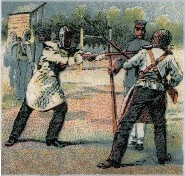
A. B. McGill and The General Store
©2014 All rights reserved.
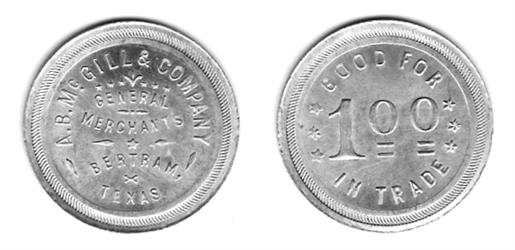
I quickly set to work looking online for whatever I could find out about McGill’s because for me it is the very specific history of these little gems that makes them so appealing. I soon learned that the building is still standing and that some photos have even been posted on line. Knowing that Bertram is about 40 miles northwest of Austin, I decided to put it on my driving route for the next time I was headed south from my home near Dallas.
The Internet is such a magical tool, and before long, I was able to assemble quite a bit of information about the building, the store, and the people who had owned and run it. But more than that, I also came to see that this particular token represents a whole broad category of tokens within the wider category of U.S. trade tokens. In so doing, it encapsulates a broad panorama of not just Texas history but U.S. history as well. As I would soon come to see, A.B. McGill’s was much like so many of the general stores that were once a central feature of almost every U.S. (and Canadian) town.

In 1880 South Gabriel had thirty-nine residents, served by a church and a school as well as two stores, a hotel, a saloon, a cotton gin, and several other businesses. When the Austin and Northwestern Railroad Company was planning its Austin-to-Burnet route, residents of South Gabriel offered a $3,000 incentive to build through their town; the company declined the offer, however, and bypassed South Gabriel by about two miles. Many residents moved their homes and businesses to the new town of Bertram on the railroad, and in 1882 the South Gabriel post office was moved to Bertram….A few houses were shown on 1940s county highway maps of the area, but in the 1980s only a cemetery marked the townsite. 1
Among many insights to be gained from this short summary is that the coming of the railroad was a pivotal event in the eventual establishment of McGill’s. The small group of residents wanted that railroad to come through South Gabriel so very much that they were willing to offer what must then have been an enormous sum! We can only assume that they believed a whistle stop would be not only very convenient but would also lead to growth and to certain prosperity. But the railroad company declined. One can only wonder why.
Bertram is located in the very scenic and popular Texas Hill Country, which is primarily limestone and caliche (a sedimentary rock) with a thin covering of topsoil. The landscape varies from relatively flat to rolling hills, with many rock creek beds (usually dry) and plenty of steep rocky hills. It was once an ocean bottom, and it is a land that is slow to recover from change.
The appearance of the Hill Country today is far different from the way it was described by the pioneers of the 1800’s. Today it is dominated by Live Oaks and especially a Texas-size weed we call “cedars” (Ashe junipers) – oh, and sprawling subdivisions radiating ever outward from Austin and San Antonio. And yet the biggest single factor affecting the land, from nature’s point of view, was the plowing of fields and the overgrazing of livestock in the late 1800’s. But I would bet that the railroad’s decision about where to lay its track was based on a very different view of the land – probably the costs of laying track in rocky and hilly terrain.
Another visit to the Handbook of Texas Online yielded some interesting information about the Austin and Northwestern Railroad:
On April 29, 1881, the Austin and North Western Rail Road Company was incorporated to build a line from Austin to a connection with the Texas and Pacific at Abilene.…The railroad carried all of the granite from Granite Mountain, nearly 16,000 carloads, used to build the state capitol. Several cars derailed near Brush Creek in Travis County, and granite blocks can still be found in the streambed.2

Imagine that! This little railroad carried all of the granite used to build the State Capitol! A quick trip to the online Wikipedia revealed that Granite Mountain is “a solid dome” of pink granite rising over 860 feet, one mile west of Marble Falls (23 miles southeast of Bertram). But what has this to do with McGill’s general store? Once more, the Handbook gives valuable information:
The town [of Bertram] was established in 1882, when the community of San Gabriel in Williamson County was moved two miles northwest to the newly constructed Austin and Northwestern Railroad. The new community was named for Austin merchant Rudolph Bertram, the largest stockholder in the Austin and Northwestern. A post office opened in 1882, and by 1891 the town had an estimated population of 150, a cotton gin-gristmill, three general stores, a grocer, a blacksmith, a shoemaker, and two wagonmakers. After 1900 Bertram was a shipping point for cotton, cattle, and wool. In 1928 a record 11,624 bales of cotton were ginned in the town. In the early 1930s plummeting cotton prices and the Great Depression caused the town’s population to decline from a high of 1,000 in 1929 to 550 by 1931…. In 1990 the population was 849.3 [1,487 in 2011]
So, the town of Bertram was formed as a stop on the new railroad and named for its largest stockholder; its primary industry was cotton, cattle, and wool; and it supported three general stores in 1891. Was McGill’s perhaps one of them? As we will see, that’s a yes and a no .
Continuing to “let my fingers do the walking,” I found out that the Burnet [pronounced “Burn-it”] County Genealogical Society had three articles specifically relating to McGill’s. One was readable on line and two were available as photocopies on request. Within days, I had all three articles in hand. The earliest was written in 1992 when McGill’s was still a general store and still open for business. It began with a photo of the building, the heading, “McGills Dry Goods, Oldest store in all Burnet County,” and the photo caption, “McGill’s store in Bertram is a throwback to the old days when small-town mercantile stores ruled the rural Texas landscape.” 4 Could this be true? Did small town mercantiles really rule the landscape?
My mind began to run in all directions. I began to think of the huge numbers of tokens that bear the inscriptions general store, mercantile, dry goods, general merchants, and general merchandise – not just in rural Texas but in nearly every state. And how many more tokens are from similar establishments that just didn’t include those particular words in whatever the owners had stamped on their tokens? We know that many of them just put denominations and names – good for 10¢ at Smith and Jones or 25¢ at Hoodoo and Hay’s – and many are “mavericks” that do not even mention the towns they were from. And then I remembered Love’s Store.
From 1990-93, I had the wonderful opportunity to experience small-town living in Center Point, Texas. This was also a Hill Country town – population about 600, about 50 miles northwest of San Antonio and a little over 100 south of Bertram. Still open for business through all the time I lived there was a true blue general store that I can only imagine was very much like McGill’s. I only wish I had taken more pictures and made an effort to capture what I did not realize at the time was the very end of an era for a major part of rural America.

Love’s Store (left), Center Point, TX, 1990
Owned by Mr. and Mrs. Love, this was an old store in an old building in a tiny old town, originally founded as Zanzenburg around 1859. Entering Love’s store was like stepping back into another age as soon as you walked through the door. What I remember most was the creaking of the wooden floorboards and the enormous array of – well, everything – whatever one might need. Like the proverbial “soup to nuts,” there were tools, and belts, and pots and pans, and postcards, and toys, and batteries and hats, and tissues and mousetraps, and jewelry and gifts…. The only thing lacking was much room to move. The prices seemed very reasonable, and being there was just plain fun. It never occurred to me that Love’s would be gone in just a very short time. By 2001, the building still stood but the general store was no longer there. How very similar was a description of McGill’s in an article written in 2008:
The store still stands….But it stands empty….When you stepped inside, the old wooden floor would creak, telling the salespeople someone had entered. Immediately you smelled fabric dye from the denim jeans, cotton dresses and wool coats. You could glance down the display cases that filled half the bottom floor of the huge stone store. You could stand in one spot and see everything….The huge stone building was erected in 1905 by D. C. Reed and in 1912 Brown McGill became a partner. He ran the merchandise end of the business while Reed continued in commodity-buying and money-lending on wool, mohair, cattle and small grains. On the second floor of the building was the furniture store, and an undertaking business was still in operation into the late 1920’s. The town was a bustling place with cotton and livestock being shipped out regularly at the depot just across the street. Farmers and ranchers could choose from several banks, cotton gins and stores. 5

My continuing research led to a wealth of information from a variety of sources which, if not specifically referenced, will appear in this article’s end notes. I learned that Reed and McGill were brothers-in-law. D.C. Reed married Laura Moses, and A.B. (Archibald Brown) McGill married her sister, Clara. When McGill joined Reed, it was initially as an employee at an agreed salary of $100 a month. McGill had been in the mercantile business in nearby Burnet, working for another token-issuing establishment, the Badger-Johnson Co. McGill died in 1934, and Clara took over with the help of their two daughters until her own death in 1949. One of the daughters, Ada Reed, had become actively involved in 1939. When Clara died, Ada Reed and her husband, Bob Brewer, became the owners and continued to manage the store until Ada Reed’s death in 1991 and the store’s closing in 1993.
As luck would have it, a former employee of McGill’s, Teresa Nyquist Tucker, has posted some very colorful and firsthand recollections at Ancestry.com:
I worked at McGills when I was in 10th grade in 1970-71 (I was 15), my first real job, making, I believe, 75 cents an hour. It was a wonderful store. The back door entrance led into the grocery section to the left (where you could get a cold Coke). Seems like the children's clothes were near the groceries and the office was to the right. As you came in the side door on the east, the office was on the left and to the right was the men's section. The front door on the left led into the shoe department.
But my favorite section was the one entered through the right door. This section had beautiful, expensive glassware such as Lalique. In front of the glass cases were display cases full of glittering costume jewelry, big gaudy brooches being a specialty.
You could also buy sewing notions, greeting cards, underwear to fit anyone in the family, nice dresses for women, and cool clothes for teens. As a teen who loved clothes, I always had something on layaway and usually spent my entire paycheck in the store. One Christmas, I saved enough to buy my mom a piece of Lalique.
The store absolutely fascinated me. Along with the new clothes there was also merchandise that had been there for 10 or more years. For instance, under some of the counters there were some boys’ shirts, in “as new” condition, still in their cellophane-type wrap that had to be from the ’60s or ’50s. Some of the greeting cards and buttons were relics too, but I thought it was great.
I enjoyed helping the older women find and try on dresses – I was at their beck and call as customer service was the #1 duty.
Bob and Ada Reed Brewer owned the store. Mrs. Brewer acquired it from her family. She did all of the buying and would make trips to the market in Dallas.…Two nice ladies who worked there and had worked there for years seemed absolutely ancient to me. I think their names were Nan and Lila. We rang sales up on an old fashioned cash register with the big round buttons that made a ka-ching type sound when you opened it. It was great…. McGill's is one of my favorite memories of that place and time.
How fitting was her description with what I remembered of Love’s Store in Center Point.
So, Ada Reed and her husband got McGill’s from her parents, who had gotten it from a D.C. Reed. What could I learn about him? My research continued with exciting results.
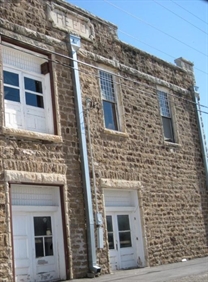
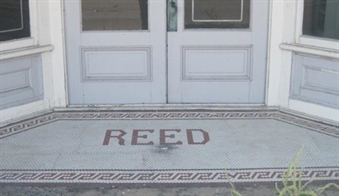

Born in 1883, David Cleveland Reed began in the mercantile business in his father’s general store, which became T.S. Reed and Son. T.S. (Thomas Seldon) Reed and his family had been part of the move from South Gabriel to the new Bertram in 1882, just a year before D.C.’s birth. T.S. sold the business to son David for about $22,000 in 1904, having already moved to Beaumont where he had established the T.S. Reed (wholesale) Grocery Co. Thus, when David took over the business in Bertram, the general store was already perhaps 22 years old, and in 1905, he built the new building that would later house McGill’s. This explains why it is Reed and not McGill that is etched in stone at the top of the building and set in tiles in the entryway.
D.C. moved to Austin in 1914. There he became a very prominent civic leader, a true business tycoon, a partner in the famous Driskell Hotel, and the owner of a mansion known today as the Byrne-Reed House. 6 He died tragically in a small plane crash in 1948, and a lawsuit documents the battle over insurance premiums to be paid to his beneficiary. As a side note, many businesses of interest to collectors are preserved in the legal record, having often been involved in lawsuits that also, in a real sense, made history.

Malcolm, Thomas, and David Reed (at right)
Courtesy of the Reed family

I was able to make Bertram a stop on a trip to Austin in October, 2011. I took lots of pictures, including those shown here. A broken window allowed me to take pictures of the inside, but I was not able to actually go in.
In 1993, the Burnet Bulletin printed an article about the closing of McGill’s. In addition to presenting some marvelous and historic photographs, it referred to McGill’s as one of the oldest mercantile institutions in Texas, in continuous operation for 111 years! 7 It went on to say that “ The pioneer store had its beginning in 1880 when T.S. Reed became part of the management team of the M.B. Lockett mercantile business in South Gabriel. The store was physically moved to Bertram in 1882 to be on the Austin and Northwestern Railroad line.”
So, in answer to my question: yes, McGill’s was one of the three mercantiles in Bertram in 1891, but not yet in that building and not yet as McGill’s. And now it was clear that even T.S. Reed & Son was not the beginning of this very old establishment; it was itself the product of an even earlier establishment, M.B. Lockett’s, of which I hoped to learn more.
As I neared what I thought would be the end of my research into a $1.00 token that had already paid great dividends in historical insights, I stumbled upon the find of a lifetime, at least as far as McGill’s was concerned. It was a reference to an oral history of Ada Reed McGill Brewer and her husband, Bob. Incredible! It seemed that someone had had the wisdom and foresight to record the recollections of the people who had actually owned and run the store for half a century. A little more online digging revealed that I could order a transcription for $15 from the Oral History Program of the University of North Texas in Denton.
Now, what quickly turned this unfolding drama into a bit of a comedy was when my oral history packet arrived a few days later. Attached to the back of the 100-page transcript were associated appendices, including copies of key letters, a detailed advertisement from 1898, several newspaper articles, and (are you ready for this?) a February 1983 TAMS article on this very same subject! It was written by the venerable and late William Fowler, who contributed enormously to the cataloguing of Texas trade tokens.

Mr. Fowler’s short article highlighted the fact that the McGill tokens are only known in 50¢ and 1.00 denominations, suggesting that there were still enough of the T.S. Reed & Son tokens in the smaller denominations to make the stamping of them unnecessary. 8
Though sole owner from 1904, it appears that D.C. retained the T.S. Reed and Son name at least through 1912 but had changed it to D.C. Reed & Co. by 1919 when he sold the business entirely. 9
It seems that T.S. Reed’s older son, Malcolm (1876-1945), also ran a general store. His was at 3 rd and Main in Marble Falls and issued trade tokens under “M. H. Reed & Co.” Malcolm also appears in the family photo shown earlier. Another Reed token was issued by the banking and mercantile establishment of Potts-Connell & Reed in nearby Liberty Hills, 10 miles east of Bertram. 10 Which Reed that was is not yet clear.
The oral history appendices include a letter revealing that D.C. Reed sold his Bertram business to Carter and S.D. Moses, no doubt relatives of his wife, Laura, and McGill’s wife, Clara. The letter also states that the company will, as of January 1, 1920, be “under the firm name of A.B. McGill…[his] having previously acquired a controlling interest.”
From the many articles included as appendices of the oral history, it is clear that generation after generation has taken an interest in McGill’s – we are not the first. “Today and Yesterday Mingle at McGill’s” was the title of an article published in the Bertram’s Emporium in 1971. It, in turn, quoted an earlier article that The Highlander had printed in 1960:
Five-cent calico, cracker barrels, buggy whips and bulk brown sugar are gone. But bottles of Garrett’s snuff are still there, along with frozen dinners, electric blankets and chic ensembles for mademoiselle….The visitor can roll away the years and visualize grandma’s girlhood in the same two-story stone building.
A 1985 article about McGill’s included these most delicious lines for token hounds: “Back in that day and time, merchants bought the produce straight from the farmers.…Farmers would trade their crop for credit tokens, and that is the reason McGill’s also operated a bank in the back corner of the store at one time.” The old, hand-painted safe was said to contain a treasure of old photographs and early business correspondence, as well as the store’s early trading tokens, “and if you’re lucky, Bob Brewer may show them to you.” “You’d be surprised how many collectors come in and want to buy them,” he said. “But I wouldn’t part with them.”
The oral history takes us back to the store’s beginnings, including a 1950 letter by Kate Lockett Vadin:
My father, M.B. Lockett, established this business in a little community called Cedar Mills where I was born, south of Gabriel Mills [South Gabriel] where my father later moved his business when I was 2 years old…..my father had sold his business and home to T.S. Reed in 1888, and we moved to Georgetown and [he] established his mercantile business anew….If you are ever in Georgetown, you will see across the front of the First National Bank my father’s store building. It has his name, M.B. Lockett, high on the front.”
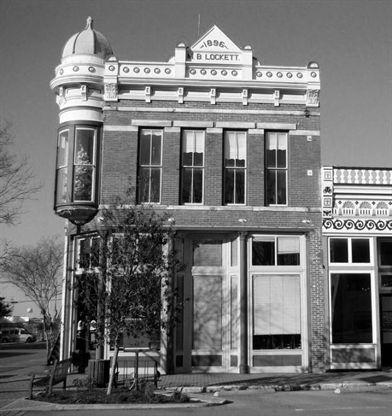
1896 M.B. Lockett Bldg, Georgetown, TX
Photo by Jeff Lockard
So then, the first McGill’s was not a Reed store at all! It originated about 1865 with M.B. Lockett’s general store in the now vanished community of Cedar Mills. It then moved with Lockett to South Gabriel about 1871 and then, still as Lockett’s, to Bertram in 1882. In 1888, Lockett sold it to T.S. Reed, who as we know sold it to his son in 1904. It then moved into new quarters in 1905 where it became McGill’s in 1920 and remained so until it closed in 1993. The building continued as an antique store until 1997 but has been vacant ever since.
Space permits sharing only a few of the most salient findings from the oral history and its attachments. How wonderful that all are available as a permanent record through the Oral History Program of the University of North Texas for all who might be interested in further details.
Apparently the first Reed store in Bertram was built with stones from the South Gabriel school building. It stood one door east of the present location, in the smaller building shown at left in the first of my photos of McGill’s (with the water tower behind it). Ada Reed said it was used like an outlet store for special sales until a truck slid into it and knocked off a corner about 1978. The building is a barbecue establishment now.
Bob Brewer explained that the Austin and Northwestern Railroad was formed for the very purpose of carrying the granite to build the capitol, and it refused the offer to pass through South Gabriel because of possible flooding from the river. He spoke of the endless salesmen coming to hawk their wares, the coming of electricity and refrigeration, the challenges of the Great Depression, and his being drafted for WWII. He described the dance hall that was opened in the upstairs of the store and operated from 1939 to 1942 with live music by local groups and as many as 300 people on a Saturday night. That same upstairs had been used as a funeral home in the 1920’s until about 1935. Ada Reed recalled that:
Mr. Thurlow Weed in Austin did the embalming, and we carried the caskets and did all of the services and everything. We had a hearse….We used to cover the boards they lined the grave with. I helped cover these with a little tack hammer and these little carpet tacks.…That kept the dirt from falling into the grave…because this is caliche.

Austin was about 40 miles away, which must have been a significant distance in the 1920’s. And to think that Thurlow Weed even issued a “token”! (I put token in quotes because it does not indicate that it was good for anything and might have been only an advertising piece.)
I think now of all the history McGill’s represents, and of how much change Ada Reed and Bob Brewer must have seen. No doubt change is the one great and predictable constant. The coming or leaving of the railroad must have made or broken how many communities? Changing markets must have made or cost how many their fortunes in the days when cotton or some other commodity “was king”? Man’s ranching and farming has forever changed how many landscapes? The coming of electricity, refrigeration, good roads and bridges, population growth, air travel, the various wars…all witnessed by the Brewer’s during their tenure at McGill’s. But “time waits for no man,” and we, too, are living a history that is now being written. I wonder what the collectors of tomorrow will make of our coins, watches, pocket knives, iPhones, and whatever else they deem to be of value.
It is said that energy is never created or lost but only changes form. It’s an interesting parallel. Towards the end of their oral history interview, the Brewer’s were asked about the future and what they saw for McGill’s general store. Ada Reed replied, “When we are gone, that is the end of the store.” Indeed, the general stores as the Locketts, Reeds, McGills, and Brewers knew them are gone now. The buildings may stand but not as they were. Where then do we go now for our hats and our mousetraps and jewelry and tools? In that must be the general store where we shop today.
The author most gratefully acknowledges the contributions of all who have added so much meaning to just one little token from just one general store in just one small town, yet representing so much of life in another time.
8 Fowler, William, “A Hundred Years to the Day,” TAMS Journal Feb. 1983, pp. 28-30.
9 Appendices of a 1984 interview with Ada Reed Brewer and R.E. (Bob) Brewer, North Texas State University Oral History Collection, Number 90.
10 See Texas Trade Tokens, 4 th Printing of Compiled Listings , © Jerry Adams 2009, posted at http://tokencatalog.com/reference%20pages/TEXASTOKENS%2013%20nov.pdf
